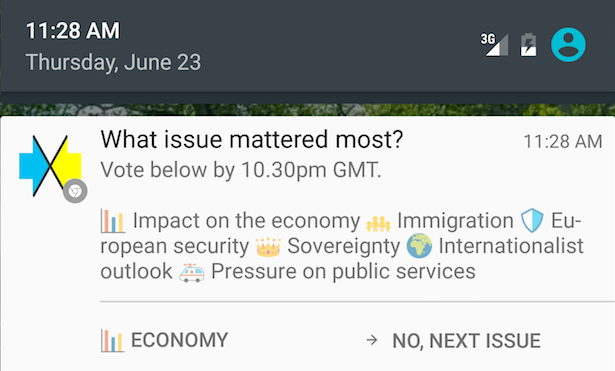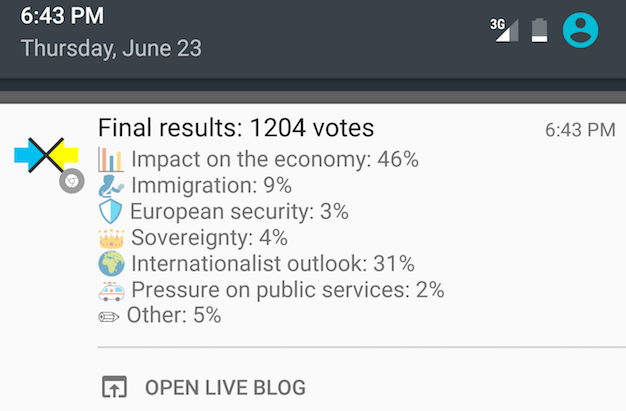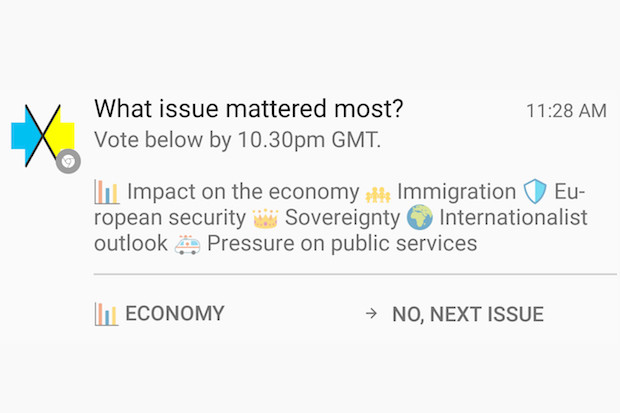Since the Guardian Mobile Innovation Lab announced its five areas of focus in March, including push alerts, the team conducted three experiments with web notifications in Google Chrome: to cover the release of April's jobs report in the US, to send updates about the US presidential election primary on 7 June and most recently, to deliver live polling data and results from the EU referendum on 23 and 24 June.
With notifications, the Lab has been exploring and will continue to explore different aspects, such as sequential and interactive alerts, live polls, replies and auto-updating alerts – last week's experiment was the first one to send people a multiple-choice live poll in a push notification.
The Lab's team of five, including two developers who created the live polling system, worked with staff from the Guardian's live news desks in the UK and the US to shape the tone of the alerts.
Although the experiment was not initially meant to kick off until the evening of the 23rd, when results would have started coming in, more than 7,000 people had already signed up to receive the alerts beforehand, so the plan changed slightly to accommodate readers' interest.
"We sent our curtain raiser, saying that we will start sending people updates, at about 5pm UK time," Sarah Schmalbach, the Lab's senior product manager, told Journalism.co.uk.
"People were finishing work for the day and a lot of them had already voted, so we wanted to give them a heads up that updates would be coming in throughout the night."
They also sent out the first live poll in a notification, asking people whether or not they thought the rain would impact voter turnout. The push alert came with a button that sent readers to the Guardian's live blog on the website.
Our first poll results are in! People > Rain squeaks by. pic.twitter.com/qdc2132sUp
— Madeline Welsh (@madelinebwelsh) June 23, 2016
Between five and 10pm, alerts went out with updates about financial sector views on a potential Brexit, information about the turnout in Scotland, and a single, auto-updating alert that would automatically refresh with the latest polling data once it had landed on people's homescreens.
A more complex poll was also sent on Thursday, where people were asked what factors had predominantly impacted their vote to Leave or Remain, choosing from five options, including the economy or immigration.
The format of the push alerts was a mixture of text and emojis, which the team used as visual cues for the polls to frame both the questions and the answers people could choose from.

All in all, almost 14,000 people signed up to the project, and compared to the Lab's previous experiment in the Guardian newsroom, where many were interacting with the notification on desktop, 93 per cent of readers this time received alerts through Chrome in their mobile browsers on Android smartphones.
The remaining 7 per cent had updates delivered either on desktop or other Chrome iterations on other devices, such as smartwatches (the team is hoping to try out a similar experience for iPhone users once iOS 10 is released in the autumn).
For 24 June, after the official results had come through, the plan was to send a selection of quotes and reactions from world leaders, but the team decided to change this approach.
Instead, they sent another live poll, this time asking people what they felt more concerned about post-referendum: movement between borders, jobs, education, or the strength of the pound.
"It was too chaotic the next morning to try and make a narrative from the different kinds of reactions and contradictions, that we felt it wouldn't be very helpful or valuable to readers to know what was going on if we had sent a selection of quotes," Sasha Koren, editor of the Guardian Mobile Innovation Lab, said.
"So we did a poll instead and we told people how long the poll would be open for. Within half an hour we sent another alert with the results from that vote."

People seemed keen to engage with the alerts – from the moment results started coming in shortly before midnight on 23 June, the live-updating notification was on their screen for "about 8-10 hours" and 77 per cent of those 13,000 readers who did receive the live notification clicked through to the live-blog on the Guardian website at some point, Schmalbach said.
"Going into it, we weren't sure if the notification would stand on its own as an independent piece of content, we didn't know whether or not people wanted to click through for more.
"But the high level of engagement seems to support the fact that notifications can still very much work in concert with bigger pieces of information, articles or ongoing blogs, and they are a quick, easy and convenient way people can choose if and when they want to click through."
Notifications can still very much work in concert with bigger pieces of information, articles or ongoing blogsSarah Schmalbach, Guardian Mobile Innovation Lab
The live polls also seemed to attract readers' attention and response. Between 20 and 25 per cent responded to the poll about what had impacted their vote most, with some 12 per cent taking part in the poll the following day – "I think people might have been pretty burned out by then and maybe didn't want to think about what they were most concerned about," she added.
The team also sent a feedback form to everyone who took part in the experiment, asking them 15 questions about their experience that "you can't find through data", explained Schmalbach. From the 2,700 people who responded, 90 per cent thought the number of alerts they had received had been "just the right amount or maybe even too few" and they also found the use of emojis "useful and interesting".
One change in the team's approach, compared to previous web notifications experiments, was the interaction around a user dismissing a push notification.
"We previously assumed people wouldn't want an alert to reappear when there's new information if they'd dismissed it before, but we got direct feedback from Android users who told us otherwise.
"So we turned that around and assumed they would want it to reappear. We added an action button to the live-updating alert throughout the evening, so people could stop it at any time, which was as big functionality change this time around," said Schmalbach.
The Guardian Mobile Innovation Lab is planning to continue expanding the web notifications experience, building on what they have learned from previous experiments by potentially covering another US jobs report or a bigger news event such as the upcoming Olympic Games in Rio.
Free daily newsletter
If you like our news and feature articles, you can sign up to receive our free daily (Mon-Fri) email newsletter (mobile friendly).
Related articles
- Sky News and BuzzFeed UK collaborate on livestreaming UK general election 2019 overnight show
- IMPRESS releases new guidance to help journalists report on election polls
- World Mental Health Day: How can journalists and news audiences take better care of themselves?
- UK independent news producer buys Belgian broadcaster ahead of Brexit
- Tip: Essential questions to ask when reporting on public polls










